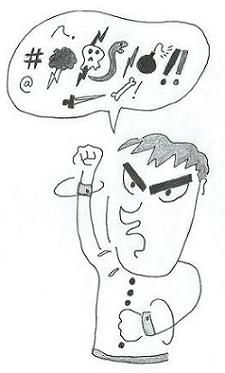
In grade school and high school, I often worked as a caddy, hitchhiking to a golf course in the morning. (Oh, weren’t those the carefree days.) Flat rate for 18 holes paid $1.75 for carrying a kangaroo bag with a fifth of scotch stashed in the pouch; if you carried “double,” scurrying after two shooters, the rate jumped to $3.50. I used to play golf, too, on the free days when courses accommodated their toilers. And the two facts are not un-connected; it was caddying that cured me of golf.
The truth is that I must not have been a very good caddy; I certainly never made much money. The main trouble? I just couldn’t keep from laughing—not from the contrived golf jokes mind you. Judging from one exchange I remember, golfers must not have found my lippy retorts endearing:
Golfer: “Son, on Saturday mornings the choice for me is between golf course and intercourse.”
Caddy (me) “No kidding, sir! Which one ’ja pick?”
It was the profanity that followed the bad shots that really got to me. Golfers like their fairways green and the air blue, and as a parochial school kid, the magnitude of swearing that these crotchety duffers generated cracked me up. I vowed never to become like those old guys. For their part, they surely believed that I was snickering at the hooks, toppers, shanks, and slices—which didn’t help me any as they re-calculated my tips.
Thinking back on all the cussing raises the pertinent point, why should so many play at a game that so enrages them? Cutting-edge brain science actually comes to the rescue here, partly. The hard consonants, plosives, and fricatives that are common to most cuss words—cotton pickin’ chicken pluckin’—may well play a role in releasing tension. (Go on… try a few of these aloud.) In 2009, neuroscientists from Keele University in the UK discovered that cursing lights up the circuits on the brain’s right side and this actually alleviates pain. Cursers who, experimentally, plunged their hands into ice water reported less discomfort. But neuroscience does not yet explain why players play an annoying game.
Believe it or not, it’s the hazards themselves that keep them playing. To make sure that the game favors only the most graceful under pressure, landscape architects have long conspired with players’ distractibility and temperament by purposely filling golf courses with magnetic sand traps, exasperating ditches, thwarting oaks, and sinuous waterways that will swallow a golf ball without pity. Hazards such as these make courses more tantalizing by giving players more to overcome besides hostile winds and clumsy swings. Golfers love to compete, and competition, even if it with oneself or the landscape, often anchors play. Robert Trent Jones, the renowned Cornell University architect who made designing golf courses his life’s mission, believed “in holes that required dramatic, heart-stopping decisions with grave consequences for miscues.” According to his biographer, Geoff Shackleford, Jones introduced these surprises into the more than five hundred courses he designed in the twentieth century.
Thus, good course design, tuned by a devilish understanding of human psychology, insures that the very rhythm of the game of golf conspires to heighten the frustrations of a bad round. Demanding shots encourage brooders to brood, and the long interval between leaves duffers time to enlarge upon failure. Golf can indeed be a good walk spoiled. In his sprawling autobiography Mark Twain also averred that under urgent circumstances “profanity provides a relief denied even to prayer.”
Amateurs who don’t have a prayer play worst when they can find no relief. During a trying round in Florida, late night television comedian Johnny Carson once heaved a new set of clubs into the water hazard. But even pros give in to fits of fury. The notoriously explosive Tommy Bolt (“Terrible Tommy”), who won the U.S. Open in 1958, wrote a wry advice-book called How to Keep Your Temper on a Golf Course. In it he advised players “never to break your putter and your driver in the same round.”
Is catharsis good for the golfer? Proponents of profanity say yes, that swearing empowers, decreasing the sense of victimhood or reducing the bad situation to a joke. But according to clinical psychologist Alan Shapiro the answer is no. He argues in his book Golf’s Mental Hazards that “by losing your cool you have also lost your ability to think clearly and focus. You have lost the time-suspended, childlike joy that the game can evoke.” The great Bobby Jones learned early on not to pound his clubs into pretzels. In his memoir Down the Fairway, which he wrote at age twenty-five, he apologized for so early an assessment of his life by explaining that golf was not just a humbling game, it was also an “aging game.”
I’m thinking of defying that observation, though. My wife and I have for many years lived across the street from a busy well-kept public course and recently she decided to take up the game. I’ve become her caddy, advising when to hit with the three iron, when to use the newfangled hybrid wood, and refraining from telling jokes. Though her shots are not much for distance, she has the smoothest, most natural swing I’ve ever beheld. I’ve never seen balls fly truer. Now that she makes it look so easy, a heretical thought has crept in: why shouldn’t I pick up a club again? And maybe I could even get a kid to carry my $G!Xdoggone bag!


